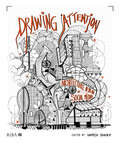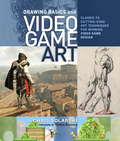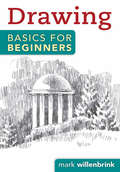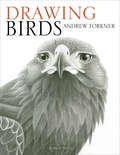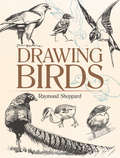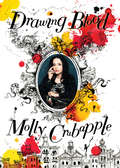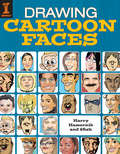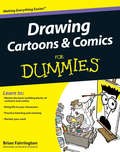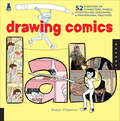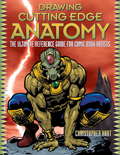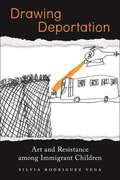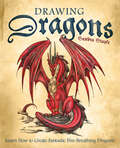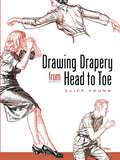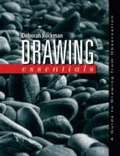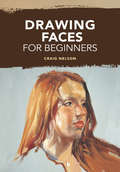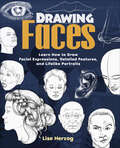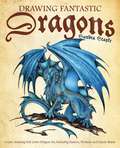- Table View
- List View
Drawing Attention: Architecture in the Age of Social Media
by Hamza ShaikhHow did you do that drawing? What software did you use? What’s your process? You may have found yourself asking these questions about a striking architectural drawing. In recent years, social media has become a primary source of expression for architects and designers, yet there isn’t always the means to find out how their works became reality. Giving you a peek behind the illustrative curtain, this book demystifies the process and technique that created some of the most outstanding drawings in your feed. Offering lessons that many universities don’t teach, it’s an essential guide for architecture students and designers, featuring profiles from highly regarded illustrators, thinkers, and emerging architectural influencers. Covering a mix of styles, concepts and mediums, it gives a detailed breakdown of a diverse range of drawing processes alongside technical tips and concept inspirations. Whether you’re a flourishing student or established professional: This is your guide to drawing attention.
Drawing Autism
by Jill MullinThis &“jaw-droppingly beautiful book&” explores the work and creative process of artists diagnosed with ASD, with a foreword by Temple Grandin (Library Journal). In this volume, behavior analyst and educator Jill Mullin has assembled a staggering array of work from established artists with autism like Gregory Blackstock and Jessica Park—as well as many who are unknown but no less talented. Their creations, coupled with artist interviews, comprise a fascinating and compelling book that serves to educate and inspire anyone who knows someone diagnosed with ASD. Mullin&’s introduction and the foreword by bestselling author Temple Grandin also provide an overview of autism, and advocate for nurturing the talents, artistic and otherwise, of autistic individuals. &“What is the actual experience of living with autism in a deep-felt sense, beyond the social stereotypes and headline-worthy superskills? Drawing Autism, a celebration of the artistry and self-expression found in artwork by people diagnosed with autism, explores just that. The stunning volume features works by more than fifty international contributors, from children to established artists, that illustrate the rich multiplicity of the condition.&” —The Atlantic &“Mullin . . . brings together fascinating works by 40 artists on the spectrum with their answers to her questions about their process.&” —The Boston Globe &“A testament to the power of art to reveal the inner world of people living with ASD.&” —Publishers Weekly
Drawing Basics and Video Game Art: Classic to Cutting-Edge Art Techniques for Winning Video Game Design
by Chris Solarski"This book supports my own 30-year crusade to demonstrate that games are an art form that undeniably rivals traditional arts. It gives detailed explanations of game art techniques and their importance, while also highlighting their dependence on artistic aspects of game design and programming." -- John Romero, co-founder of id Software and CEO of Loot Drop, Inc.Video games are not a revolution in art history, but an evolution. Whether the medium is paper or canvas--or a computer screen--the artist's challenge is to make something without depth seem like a window into a living, breathing world. Video game art is no different. Drawing Basics and Video Game Art is first to examine the connections between classical art and video games, enabling developers to create more expressive and varied emotional experiences in games. Artist game designer Chris Solarski gives readers a comprehensive introduction to basic and advanced drawing and design skills--light, value, color, anatomy, concept development--as well as detailed instruction for using these methods to design complex characters, worlds, and gameplay experiences. Artwork by the likes of Michelangelo, Titian, and Rubens are studied alongside AAA games like BioShock, Journey, the Mario series, and Portal 2, to demonstrate perpetual theories of depth, composition, movement, artistic anatomy, and expression. Although Drawing Basics and Video Game Art is primarily a practical reference for artists and designers working in the video games industry, it's equally accessible for those interested to learn about gaming's future, and potential as an artistic medium.Also available as an eBookFrom the Trade Paperback edition.
Drawing Basics for Beginners
by Mark WillenbrinkSharpen your skills with these lessons designed to help you recapture the delight you took in drawing as a child. The Willenbrinks take you through several different approaches to the same subject matter designed to help you discover the best approach--or combination of approaches--for you.
Drawing Birds
by Andrew ForknerThis book is an expert guide to producing beautiful lifelike drawings of birds in their natural habitat. Artists of all interests will find a lot to inspire them in this detailed, practical and beautiful guide on drawing birds. The book includes sections on materials, basic techniques and reference gathering, as well as how to draw the key features of birds such as beaks, eyes, claws, wings and feathers. A special section focuses on birds in flight, and this is followed by chapters on the main bird groups including: Waders and water birds, Wildfowl, Birds of prey, Owls, Garden and woodland birds, Seabirds and Game birds. Each chapter covers the techniques specific to the group as well as numerous examples and a full step-by-step demonstration. The absence of colour means that Andrew uses other aspects such as pattern, shading and shape to give his paintings life and interest. Written for artists who wish to apply their skills to drawing birds, as well as experienced artists who want to improve their drawing skills, this is an expert guide to producing exquisitely rendered, lifelike drawings of birds in their natural habitats and nothing could be more inspirational than Andrew’s accurately observed and truly beautiful drawings.
Drawing Birds (Dover Art Instruction)
by Raymond SheppardThroughout history, people have been obsessed with bird imagery, from carvings on the temple walls of ancient Egypt to modern-day murals, posters, and even tattoos. This helpful instructional volume by a renowned artist and teacher offers a wealth of well-illustrated advice on depicting all manner of birds. British illustrator Raymond Sheppard was celebrated for his nature and animal studies, and this book combines two of his most valuable guides, How to Draw Birds (1940) and More Birds to Draw (1956). Suitable for beginners as well as advanced artists, this single-volume edition of Sheppard's two great guides provides in-depth studies of the shapes and visual construction of a variety of birds, from domestic fowl to birds on the wing. Topics include anatomy; the representation of wings, feathers, and flight; and details for drawing beaks, feet, and plumage. Common birds such as thrushes, redwings, blackbirds, and starlings appear here, along with many other species, in addition to ducks in and out of the water and birds of prey such as the barn owl, buzzard, and golden eagle. Written with clarity and infectious enthusiasm, Drawing Birds offers an abundance of pointers that will benefit amateur and professional artists alike.
Drawing Blood
by Molly CrabappleArt was my dearest friend.To draw was trouble and safety, adventure and freedom.In that four-cornered kingdom of paper, I lived as I pleased.This is the story of a girl and her sketchbook.In language that is fresh, visceral, and deeply moving—and illustrations that are irreverent and gorgeous—here is a memoir that will change the way you think about art, sex, politics, and survival in our times.From a young age, Molly Crabapple had the eye of an artist and the spirit of a radical. After a restless childhood on New York's Long Island, she left America to see Europe and the Near East, a young artist plunging into unfamiliar cultures, notebook always in hand, drawing what she observed.Returning to New York City after 9/11 to study art, she posed nude for sketch artists and sketchy photographers, danced burlesque, and modeled for the world famous Suicide Girls. Frustrated with the academy and the conventional art world, she eventually landed a post as house artist at Simon Hammerstein's legendary nightclub The Box, the epicenter of decadent Manhattan nightlife before the financial crisis of 2008. There she had a ringside seat for the pitched battle between the bankers of Wall Street and the entertainers who walked among them—a scandalous, drug-fueled circus of mutual exploitation that she captured in her tart and knowing illustrations. Then, after the crash, a wave of protest movements—from student demonstrations in London to Occupy Wall Street in her own backyard—led Molly to turn her talents to a new form of witness journalism, reporting from places such as Guantanamo, Syria, Rikers Island, and the labor camps of Abu Dhabi. Using both words and artwork to shed light on the darker corners of American empire, she has swiftly become one of the most original and galvanizing voices on the cultural stage.Now, with the same blend of honesty, fierce insight, and indelible imagery that is her signature, Molly offers her own story: an unforgettable memoir of artistic exploration, political awakening, and personal transformation.
Drawing Boats and Ships
by Yngve Edward SoderbergAny artist who loves the beauty of nature and is drawn by the majesty of the sea will want to try sketching boats and nautical scenes. American painter Yngve Edward Soderberg, who spent much of his career mastering this art on the Mystic coast of Connecticut, was known for his breathtaking maritime art. In this concise guide, he makes it look easy with step-by-step instructions perfect for novices and anyone wanting to brush up on his drawing skills.From sailboats and dinghies to cruisers and whale ships, Soderberg shows how to observe and draw all that is seaworthy. Enhanced by expert commentary, over 100 illustrations include gulls, buoys, lighthouses, water surfaces, skies, clouds, and more. He even demonstrates how to sketch a boat's crew in action and offers valuable tips on perspective. Easy to follow, this essential guide helps hone all the valuable skills needed to create beautiful nautical compositions.
Drawing Cartoon Faces: 55+ Projects for Cartoons, Caricatures & Comic Portraits
by Harry Hamernik 8fishDiscover the fast and fun art of drawing comic faces! Chances are you already know how to draw some expressions. But you can only go so far with "happy," "sad" and "angry." In order to give your comic portraits some...character...you need to know what they look like when they are about to sneeze, when they smell something stinky or when they're flirting, terrified or completely dumbfounded! Good thing Drawing Cartoon Faces includes more than 70 step-by-step demonstrations to teach you how to capture the silly, whimsical and expressive faces you see in your imagination and of friends, family and strangers! With Drawing Cartoon Faces, you'll get expert instruction on: The fundamentals: Drawing heads, eyes, noses, mouths, hair and other features. The expressions: More than 70 step-by-step demonstrations for a variety of expressions and moods, from simple to subtle and complex. Storytelling: Move your story along using expression, point of view and composition. Put it all together to create multi character and multi panel art. With Drawing Cartoon Faces, you'll learn to draw like you never thought you could--and you'll have more fun than you ever thought possible!
Drawing Cartoons & Comics For Dummies
by Brian FairringtonA unique reference for creating and marketing original cartoons and comics An original American art form, comics thrill millions of people across the globe. Combining step-by-step instruction with expert tips and advice, Drawing Cartoons & Comics For Dummies is a one-stop reference for creating and marketing original cartoons and comics. While many books tend to focus on specific characters or themes, this thorough guide focuses instead on helping aspiring artists master the basic building blocks of cartoons and comics, revealing step by step how to create everything from wisecracking bunnies to souped-up super villains. It also explores lettering and coloring, and offers expert marketing advice. The book's color insert provides guidance on how to add color to cartoon creations.
Drawing Chibi Food: Learn How to Draw Kawaii Onigiri, Adorable Dumplings, Yummy Donuts, and Other Cute and Tasty Dishes (How to Draw Books)
by Tessa Creative ArtLearn step-by-step tutorials on how to draw a variety of anime- and manga-style foods, including chibi bentos, tacos, pancakes, boba, and more!It&’s time to take your drawing skills to the next level with Drawing Chibi Food! A comprehensive guide with easy-to-follow instructions and handy practice pages, this latest installment in the Drawing Chibi series will make you want to grab a delicious snack along with your sketchbook and begin drawing the most adorable versions of your favorite foods. Whether you&’re a budding artist or a drawing master, Drawing Chibi Food makes sketching foods from all around the world in an adorable anime-style fun and easy!
Drawing Chibi Pets: Learn to Draw Kawaii Companions from Dogs, Cats, and Hamsters to Lizards and Fish! (How to Draw Books) (How to Draw Books)
by Tessa Creative ArtIn Drawing Chibi Pets, learn how to bring your favorite anime and manga-inspired pets to life using step-by-step instructions perfect for beginners!Take your drawing skills to the next level with Drawing Chibi Pets! Whether you&’re just starting out or need a refresher, this workbook is a great tool to work your way up from easy illustrations. Begin with familiar drawings like dogs and cats and steadily move toward complex animals like lizards. Drawing Chibi Pets will help budding artists build and strengthen creative muscles with every page, cultivating self-confidence in your craft and yourself.
Drawing Chibi: Learn How to Draw Kawaii People, Animals, and Other Utterly Cute Stuff (How to Draw Books)
by Kikai AnimeLearn how to draw adorable manga- and anime-style illustrations, including popular chibi onesies and adorable kawaii critters, with step-by-step instructions.Open your sketch book and begin to doodle and create in your favorite anime styles with this step-by-step drawing instructional handbook for kawaii (cute) and chibi (small) people, animals, mystical creatures, food, and more. Just starting with illustrating? Drawing Chibi is the perfect guide for beginners and budding artists alike. Start with simple illustrations like an usagi (bunny), same (shark), and aisukurimu (ice cream) before moving on to fun, multi-step illustrations like the yosei (fairy), ninja, and (uber-popular) animal onesies. Each instructional series shows how to lay out the illustration, correctly size each element, then carefully draw each feature. Workbook-style pages adjoining each illustration provide a space for readers to try their hand at practicing each drawing multiple times.
Drawing Comics Lab: 52 Exercises on Characters, Panels, Storytelling, Publishing, & Professional Practices (Lab)
by Robyn ChapmanLearn all the basics of producing a comic from the first doodle to the finished publication—includes fifty-two exercises for aspiring comic artists of all ages.Do you dream of becoming a comic artist? This easy-to-follow book is designed for the beginning or aspiring cartoonist. Both children and adults will find the techniques engaging and highly accessible. Featured artists include:James SturmTom HartJessica AbelMatt MaddenEddie Campbelland many othersFeaturing fifty-two exercises meant to jump-start your creativity, this book will guide you toward effective ways to tell stories visually. It offers tips for creating and building characters, creating panels, storytelling, publishing and establishing good professional practices. Start your comic adventures today with Drawing Comics Lab!
Drawing Cutting Edge Anatomy
by Christopher HartThis drawing tutorial from best-selling author Christopher Hart shows artists how to draw exaggerated musculature of super-sized figures in action poses.
Drawing Deportation: Art and Resistance among Immigrant Children
by Silvia Rodriguez VegaIllustrates how the children of immigrants use art to grapple with issues of citizenship, state violence, and belonging Young immigrant children often do not have the words to express how their lives are shaped by issues of immigration, legal status, and state-sanctioned violence. Yet they are able to communicate its effects on them using art. Based on ten years of work with immigrant children as young as six years old in Arizona and California— and featuring an analysis of three hundred drawings, theater performances, and family interviews—Silvia Rodriguez Vega provides accounts of children’s challenges with deportation and family separation during the Obama and Trump administrations. While much of the literature on immigrant children depicts them as passive, when viewed through this lens they appear as agents of their own stories. The volume provides key insights into how immigrant children in both states presented creative, out-of-the-box, powerful solutions to the dilemmas that anti-immigrant rhetoric and harsh immigration laws present. Through art, they demonstrated a righteous indignation against societal violence, dehumanization, and death as a tool for navigating a racist, anti-immigrant society. When children are the agents of their own stories, they can reimagine destructive situations in ways that adults sometimes cannot, offering us alternatives and hope for a better future. At once devastating and revelatory, Drawing Deportation provides a roadmap for how art can provide a safe and necessary space for vulnerable populations to assert their humanity in a world that would rather divest them of it.
Drawing Digital: The Complete Guide to Learning to Draw and Paint on Your iPad
by Lisa BardotAcclaimed artist and educator Lisa Bardot gives you all the tools you need to approach creating art and illustration on your iPad, using Procreate and other popular drawing apps.- Explore the core technical aspects of your chosen app, including layers, masks, alpha lock, and brushes.- Learn how to draw plants, flowers, and animals, then move on to drawing people and more complicated scenes.- Step-by-step exercises lead you through each new topic, with plenty of tips, tricks and techniques.- An ideal starting point for newcomers to digital art, but with plenty of original inspiration and advice for more advanced artists.
Drawing Dragons: Learn How to Create Fantastic Fire-Breathing Dragons (How to Draw Books #1)
by Sandra StapleStep-by-step instructions on how to draw a myriad of fantastical, fearsome winged beasts in all their forms and poses.In easy-to-follow, step-by-step detail, Drawing Dragons teaches you all the tricks and techniques you’ll need to create your own amazing dragons. You’ll discover how to draw all types of dragons using nothing but a pencil. Drawing Dragons shows how to bring to life fierce warriors and bearded ancients as well as baby hatchlings and protective mothers. It also features a special section on adding claws, scales, horns, jewels and other unique details to your dragons.Learn to draw:Ferocious, attacking dragonsGraceful sea dragonsFire-breathing flying dragonsWise, thoughtful dragons
Drawing Drapery from Head to Toe
by Cliff YoungPacked with indispensable information on a vital aspect of drawing, this time-honored manual offers expert guidance on how to draw shirts, pants, skirts, gloves, hats, coats, and undergarments on the human figure. Step by simple step, artists will discover how these garments fit and drape the body at rest and in action. Abundant with detailed illustrations, photographs, and diagrams, Drawing Drapery from Head to Toe familiarizes readers with the properties of cloth and how it moves; it also examines the origins of folds in relation to the figure, the effects of pull and crush, action folds, creasing, and more. The result: a keen development of the essential techniques for creating realistic, masterfully rendered drawings of the clothed figure.One of few books on the subject of drawing drapery, this volume was written by a noted artist and instructor. Easy to follow, full of fascinating advice, and highly enjoyable to read, it is sure to become a well-thumbed guide.
Drawing Essentials: A Complete Guide to Drawing
by Deborah RockmanWith unparalleled clarity, Drawing Essentials: A Complete Guide to Drawing, Fourth Edition, explains in depth the essentials of depicting form and space on a two-dimensional surface, focusing on the cultivation of observational skills, increased sensitivity, critical thinking, technical refinement, and knowledge of materials. This richly illustrated text is appropriate for use in all levels of drawing classes, from introductory to advanced levels, as well as for figure and life drawing classes.
Drawing Essentials: A Guide to Drawing from Observation
by Deborah RockmanDrawing Essentials: A Guide to Drawing from Observation thoroughly covers the three drawing subcategories that are most important at the foundation level--basic drawing (non-subject specific), figure drawing, and perspective drawing--explaining clearly and in depth the elements that are essential to depicting form and space on a two-dimensional surface. This book is ideal for introductory studio art courses in drawing.
Drawing Faces for Beginners
by Craig NelsonArtist Craig Nelson shares secrets to drawing faces. From basics like materials, proportion and tone to finer details such as rendering noses from various angles, you will have all the essentials you need to get started drawing portraits immediately. Clear instruction and two step-by-step portrait demonstrations help you to create realistic faces with accuracy and ease.
Drawing Faces: Learn How to Draw Facial Expressions, Detailed Features, and Lifelike Portraits (How to Draw Books)
by Lise HerzogMake your portraits and character drawings even more realistic with these step-by-step instructions and tips. Grab your sketchbook, pens, and pencils, and follow along as this instructional drawing guide teaches you everything you need to know about creating true-to-life human faces. With more than 150 easy-to-follow illustrations, Drawing Faces is the perfect guide for aspiring artists looking to develop their portrait skills. Start off simple with learning how to draw basic facial features. By the end of the book, you will have gained the knowledge you need to make your characters&’ faces as realistic as possible, including learning to draw: *Various facial expressions *Side profiles *Lifelike portraits *and much more! Whether you&’re a beginner or a drawing pro, Drawing Faces is the perfect book to hone your technical drawing skills and take your illustrations to the next level.
Drawing Fantastic Dragons: Create Amazing Full-Color Dragon Art, including Eastern, Western and Classic Beasts
by Sandra StapleCreate and Customize the Dragon of Your Dreams!If you can dream it, this book will show you how to bring it to life in distinct and dramatic color. With easy-to-follow, step- by-step instructions, Drawing Fantastic Dragons teaches the tricks and techniques to create your own amazing art.Start with a sketch of the dragon&’s body form. Then add the head, tail, arms and legs. Next customize it with one of the many styles of horns, scales, claws and wings detailed in this guide. You will even learn how to add age, personality and animal attributes to your dragon. Lastly, author Sandra Staple shows how to finish your dragon drawing with amazing color effects. Packed with example after example, this hands-on guide features dragons of all shapes and sizes, and includes a special section on how to draw unique beasts like earth, air, and fire dragons, wyverns, hydras, and more.
Drawing Fantastic Furries: The Ultimate Guide to Drawing Anthropomrphic Charaacters
by Christopher HartENTER THE ALLURING, MAGICAL, MYTHICAL WORLD OF THE FURRY KINGDOM What Is A Furry?A furry is an anthropomorphic being--an animal with human characteristics. Furries have fascinated artists going back thousands of years and as seen in the influx of animal/human characters into popular culture, interest today is at an all time high. And now for the first time all in one volume, you'll be able to take the next step to the outer limits of your imagination with the ultimate guide to drawing your own furries--Christopher Hart's Drawing Fantastic Furries. After a basic lesson in the fundamentals of comparative human and animal anatomies, you'll learn how to draw an entire menagerie of furry species, ranging from the adorable and charming super-cute furries to the seductive and super-popular glamorous furries to the warriors, wizards, vampires, and demons of the furry occult and fantasy realms.From the Trade Paperback edition.
